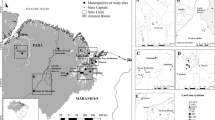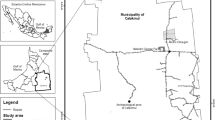Abstract
Tropical dry forests (TDFs) are being deforested at unprecedented rates. The slash/burn/agriculture/fallow-extensive livestock sequence causes significant nutrient losses and soil degradation. Our aim is to assess nutrient inputs and outputs in a TDF area under an alternative management system, for exclusive wood production. The study involved clear-cutting a preserved caatinga TDF site without burning, quantifying nutrients exported in firewood/timber and nutrients returned to the soil from the litter layer plus the slash debris, left to decompose unburned on the soil surface. Before clear-cut, the litter layer on the forest floor contained 6.1 t ha of dry matter (DM). After clear-cut, the aboveground biomass was 61.9 t DM ha−1 (consisting of 21.5 t DM ha−1 of commercial wood and 40.4 t DM ha−1 of clear-cut debris that did not include the underlying litter layer). The litter layer was composed of fine and coarse litter, with turnovers of 0.86 and 0.31 year−1, respectively, separately measured in uncut control plots during two rainy seasons (Dec-2007/June-2008 and Dec-2008/June-2009). In a single season, its decomposition returned to the soil 48.4, 1.16 and 12.3 kg ha−1 of N, P and K. The clear-cut debris was mainly composed of branches, 33.4 t ha−1, bromeliads, 5.63 t ha−1 and green leaves, 1.32 t ha−1. In-situ decomposition rates for branches and bromeliads were 0.24 and 1.47 year−1, respectively. After two rainy seasons the clear-cut debris released 206, 6.5 and 106 kg ha−1 of N, P and K respectively. This input plus that of the underlying litter layer exceeded exports in the commercial wood, and replenished a soil nutrient stock (0–30 cm) of approximately the same magnitude.



Similar content being viewed by others
References
Alves GD, Sampaio EVSB, Salcedo IH, Silva VM (1999) Potencial de mineralização de N e de C em vinte solos da Pernambuco. Rev Bras Cienc Solo 23:245–256
Andrade RL, Souto JS, Souto PC, Bezerra DM (2008) Deposição de serrapilheira em área de caatinga na RPPN “fazenda tamanduá”, Santa Terezinha–PB. Caatinga 21:223–230
Chambers JQ, Higuchi N, Schimel JP, Ferreira LV, Melack JM (2000) Decomposition and carbon cycling of dead trees in tropical forests of the central Amazon. Oecologia 122:380–388
Costa CCA, Souza AM, Silva NF, Valera RGC, Dantas IM (2007) Produção de serapilheira na caatinga da Floresta Nacional do Açú-RN. Rev Bras Biociênc 5:246–248
Devore JL (2011) Probability and statistics for engineering and the sciences, 8th edn. Cengage Learning, Boston
Dossa EL, Khouma M, Diedhiou I, Sene M, Kizito F, Badiane AN, Samba SAN, Dick RP (2009) Carbon, nitrogen and phosphorus mineralization potential of semiarid Sahelian soils amended with native shrub residues. Geoderma 148:251–260
Eaton JM, Lawrence D (2006) Woody debris stocks and fluxes during succession in a dry tropical forest. For Ecol Manag 232:46–55
EMBRAPA Semiárido (2009) Médias anuais da Estação Agrometeorológica de Bebedouro (Petrolina-PE 09°09′S, 40°22′W) Período 1975–2008. http://www.cpatsa.embrapa.br:8080/servicos/dadosmet/ceb-mes.html. Accessed 6 Oct 2014
Empresa Brasileira de Pesquisa Agropecuária–Embrapa (2006) Centro Nacional de Pesquisa de Solos. Sistema brasileiro de classificação de solos, 2 ed, Rio de Janeiro
Finegan B et al (2009) Shared functions and constraints of natural and managed systems: implications for human well-being in a changing environment. In: Tiessen H, Stewart JWB (eds) Applying ecological knowledge to Landuse Decisions. SCOPE/IAI/IICA, São Paulo, pp 14–22
Fleming R, Kanowski P, Brown N, Jenik J, Kahumbu P, Plesnik J (2011) Emerging perspectives on forest biodiversity. In: Bech S, Goverse T (eds) UNEP Year Book 2011: emerging issues in our global environment. United Nations Environment Programme, Nairobi, pp 47–59
Fraga VS, Salcedo IH (2004) Declines of organic nutrient pools in tropical semi-arid soils under subsistence farming. Soil Sci Soc Am J 68:215–224
Francelino MR, Fernandes Filho EI, Resende M, Leite HG (2003) Contribuição da caatinga na sustentabilidade de projetos de assentamentos no sertão norte-rio-grandense. Rev Árvore 27:79–86
Giardina CP, Sanford RL Jr, Døckersmith IC, Jaramillo VJ (2000) The effects of slash burning on ecosystem nutrients during the land preparation phase of shifting cultivation. Plant Soil 220:247–260
Harmon ME, Whigham DF, Sexton J, Olmsted I (1995) Decomposition and mass of woody detritus in the dry tropical forests of the Northeastern Yucatan Peninsula. Mexico Biotropica 27:305–316
Jara P, Martínez E, Campo J (2009) N and P dynamics in the litter and soil of Mexican semi-arid forests, state of Morelos. Agric Ecosyst Environ 130:164–170
Jaramillo VJ, Kauffman JB, Rentería-Rodríguez L, Cummings DL, Ellingson LJ (2003) Biomass, carbon, and nitrogen pools in Mexican tropical dry forest landscapes. Ecosystems 6:609–629
Kauffman JB, Sanford RL Jr, Cummings DL, Salcedo IH, Sampaio EVSB (1993) Biomass and nutrient dynamics associated with slash fires in neotropical dry forests. Ecology 74:140–151
Kauffman JB, Steele MD, Cummings DL, Jaramillo VJ (2003) Biomass dynamics associated with deforestation, fire, and, conversion to cattle pasture in a Mexican tropical dry forest. For Ecol Manag 176:1–12
Maass JM et al (2005) Ecosystem services of tropical dry forests: insights from long-term ecological and social research on the Pacific Coast of Mexico. Ecol Soc 10(1):17
Malmström A, Persson T, Ahlström K, Gongalsky KB, Bengtsson J (2009) Dynamics of soil meso and macrofauna during a 5-year period after clear-cut burning in a boreal forest. Appl Soil Ecol 43:61–74
Marques MWCF, Pareyn FGC, Figueiredo MAB (2011) A composição da renda e a contribuição do manejo florestal em dois projetos de assentamento no sertão de Pernambuco. Revista Econômica do Nordeste, vol 42(2). Banco do Nordeste, Fortaleza, pp 247–258
Martinez-Yrízar A (1995) A biomass distribution and primary productivity of tropical dry forests. In: Bullock SH, Mooney HA, Medina E (eds) Seasonally dry tropical forests. Cambridge University Press, Cambridge, pp 326–345
Martins CM (2009) Atributos de solos e sua relação com o processo de desertificação no semiárido de Pernambuco. Universidade Federal Rural de Pernambuco, Dissertação
Miles L, Newton AC, DeFries RS, Ravilious C, May I, Blyth S, Valerie Kapos V, Gordon JE (2006) A global overview of the conservation status of tropical dry forests. J Biogeogr 33:491–502
MMA—Ministério do Meio Ambiente Monitoramento do Desmatamento nos Biomas Brasileiros por Satélite Acordo de Cooperação Técnica MMA/IBAMA (Instituto Brasileiro do Meio Ambiente e dos Recursos Naturais Renováveis) Monitoramento do Bioma Caatinga 2002 a 2009 Relatório Técnico, Brasília, 2011
Nunes LAPL, Araújo Filho JA, Holanda Júnior EV, Menezes RIQ (2009) Impacto da queimada e de enleiramento de resíduos orgânicos em atributos biológicos de solo sob caatinga no semi-árido nordestino. Caatinga 22:131–140
Olson JS (1963) Energy storage and the balance of producers and decomposers in ecological systems. Ecology 44:322–331
Pareyn F, Riegelhaupt E, Gariglio MA (2009) Environmental impacts of caatinga forest management—a study case. In: Grossberg SP (ed) Forest management. Nova Science Publisher, New York, pp 179–202
Perrings C, Folke C, Mäler KG (1992) The ecology and economics of biodiversity loss: the research agenda. Ambio 21:201–211
Petersen RG, Calvin LD (1996) Sampling. In: Sparks DL et al (eds) Methods of soil analysis, part 3, chemical methods book series of the soil science society of America. 5 Soil Science Society of America, Madison, pp 1–18
Riegelhaupt EM, Pareyn FGC (2010) A questão energética e o manejo florestal da Caatinga. In: Gariglio MA et al (eds) Uso sustentável e conservação dos recursos florestais da caatinga. Serviço Florestal Brasileiro, Brasília, pp 65–75
Salcedo IH, Tiessen H, Sampaio EVSB (1997) Nutrient availability in soil samples from shifting cultivation in the semi-arid caatinga of NE Brazil. Agric Ecosyst Environ 65:177–186
Sampaio EVSB (1995) Overview of the Brazilian Caatinga. In: Bullock SH, Money H, Medina E (eds) Seasonally dry tropical forests. Cambridge University Press, Cambridge, pp 35–63
Sampaio EVSB, Silva GG (1996) Ciclagem de nutrientes. In: Sampaio EVSB, Mayo SJ, Barbosa MRV (eds) Pesquisa Botânica Nordestina: progresso e perspectivas. Sociedade Botânica do Brasil, Recife, pp 191–201
Sampaio EVSB, Araújo EL, Salcedo IH, Tiessen H (1998) Regeneração da vegetação de caatinga após corte e queima, em Serra Talhada, PE. Pesqui Agropecu Bras 33:621–632
SAS Institute (2002) Software and services: system for Windows, versão 8.0
Silveira DG, Lino LSM, Souza AS, Souza FVD (2013) Somatic embryogenesis of Neoglaziovia variegata (Arruda) Mez, an important source of fiber from native Brazilian bromeliads. Braz Arch Biol Technol 56(4):547–555
Snyder JD, Trofymow JA (1984) A rapid accurate wet oxidation diffusion procedure for determining organic and inorganic carbon in plant and soil sample. Commun Soil Sci Plant Anal 15:587–597
Thomas RL, Sheard RW, Moyer JR (1967) Comparison of conventional and automated procedures for N, P and K analysis of plant material using a single digestion. Agron J 59:240–243
Tiessen H, Salcedo IH, Sampaio EVSB (1992) Nutrient and soil organic matter dynamics under shifting cultivation in semi-arid northeastern Brazil. Agric Ecosyst Environ 38:139–151
Acknowledgments
The first author would like to thank the scholarship received to pursue this study, Granted by CAPES (MEC/Brazil), through the graduate program in Soil Science at UFRPE, the Brazilian Agricultural Research Corporation unit in the Semi-Arid (Embrapa Semiárido) and also the help in the field offered by Kleber Costa (APNE). The authors thank the anonymous reviewers that contributed to the improvement of the manuscript.
Author information
Authors and Affiliations
Corresponding author
Rights and permissions
About this article
Cite this article
Amorim, L.B., Salcedo, I.H., Pareyn, F.G.C. et al. Assessment of nutrient returns in a tropical dry forest after clear-cut without burning. Nutr Cycl Agroecosyst 100, 333–343 (2014). https://doi.org/10.1007/s10705-014-9646-5
Received:
Accepted:
Published:
Issue Date:
DOI: https://doi.org/10.1007/s10705-014-9646-5




